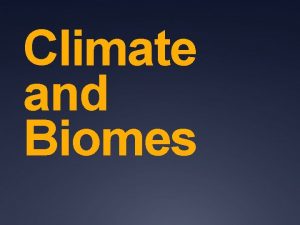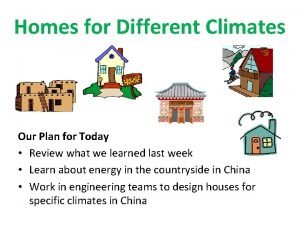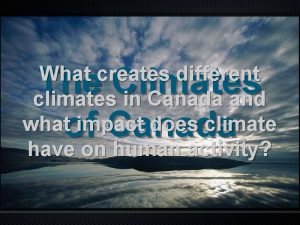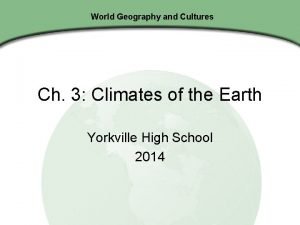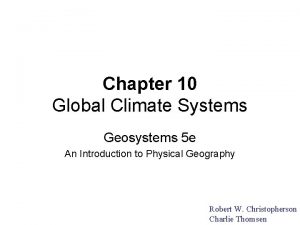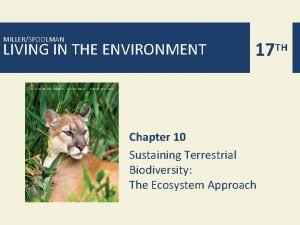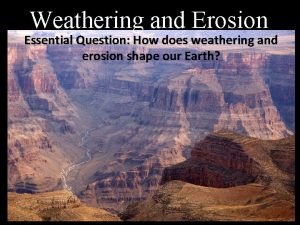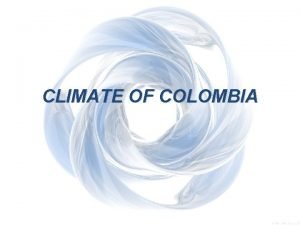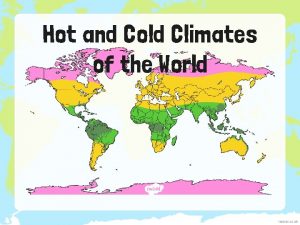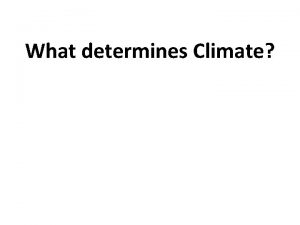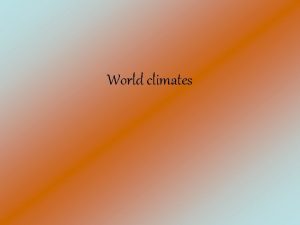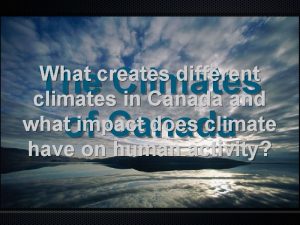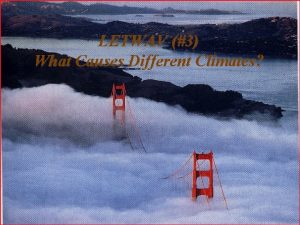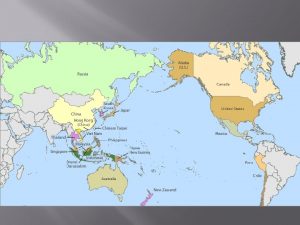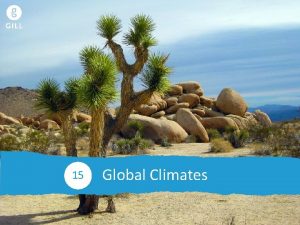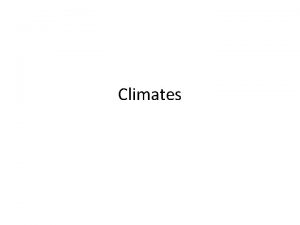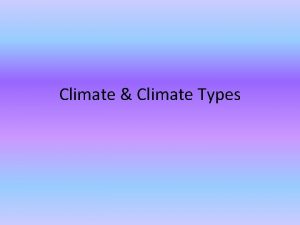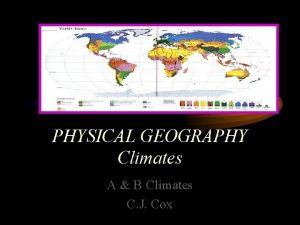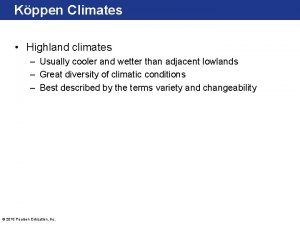What Causes Different Climates Map of World Climates


















- Slides: 18

What Causes Different Climates?

Map of World Climates

I. The Significance of Climate and Biomes A. What is the difference between climate and weather? 1. Climate: the average, year after year conditions in a particular region 2. Weather: the condition of the atmosphere at a certain time and place 3. BOTH are measured in terms of temperature, wind speed, humidity, cloudiness, precipitation and other variables. B. What is a biome? 1. Biomes areas that are similar in climate and other physical factors 2. These areas tend to develop similar communities of plants and animals. Powered by the sun, the climate system is a complex exchange of energy and moisture among Earth’s atmosphere.

II. Global Climate Controls Latitude Elevation Topography Water Bodies Atmospheric Circulation Vegetation

A. Latitude 1. Because the Earth tilts on its axis, and because the earth is spherical the Sun’s rays strike the Earth at different angles. a. as a result, different parts of Earth receive different amounts of solar radiation.

3. The tropics receive the most solar radiation because the sun’s rays strike almost directly. Temperatures in the tropics are warm yearround. 4. The temperate zones have moderate conditions. 5. The polar zones receive the least radiation because the suns rays strike at a very low angle. Temperatures in polar regions are usually cold.

B. Elevation 1. Elevation is the height above sea level. 2. On average, air temperature drops about 6. 5ºC for every 1000 m of altitude. 3. The higher the elevation, the colder the climate

C. Topography 1. Climates often differ on either side of a mountain. 2. As air rises over a mountain, it cools. As it cools, it condenses, and releases moisture (rain). This is called the windward side. 3. As the dry air flows over the mountain, it descends and warms, usually producing deserts. This is called the leeward side.

e Sid rd wa nd ns Wi tai un e Mo Sid rd wa Lee Direction of Prevailing Winds

Deserts such as the Atacama in Chile are common on leeward sides of mountains. The dry area is Called a rain shadow and can extend for hundreds of km downwind of a mountain range

D. Water Bodies 1. Land gains and loses heat much faster than water. 2. The temperature of a large body of water can influence the temperature of the air above it. 3. Based on other factors certain areas closer to large bodies of water may have a relatively small yearly temperature range. a. example: the California coast vs. the interior of California 4. Continental interiors have large yearly temperature ranges 5. Dry air gains and loses heat much faster than humid air, so deserts have large daily temperature ranges

Water Bodies (Continued) 1. Ocean currents can warm or cool the air above. 2. Ocean currents may be considerably warmer or colder than the normal air temperature for that latitude.

E. Atmospheric Circulation 1. Solar energy and earth’s rotation create motion in the atmosphere called planetary winds. 2. There are three basic wind systems in each hemisphere: Polar Easterlies, Northeast or Southeast Tradewinds and Prevailing Westerlies. 3. These winds blow air masses with distinct regions of origin (ie. formed over land or water, formed at certain latitudes). 4. Winds move warm air toward the poles and cool air toward the equator.

These belts shift seasonally as the earth spins on it’s axis and different latitudes receive direct sunlight. In the Northern Hemisphere, belts shift northwards in the summer, and southwards in the winter.

F. Vegetation 1. Vegetation influences how much of the sun’s energy is absorbed and how quickly this energy is released, which affects the climate. 2. During transpiration, plants release water vapor from their leaves into the air.

F. Vegetation, cont. 3. Some plants release particles that promote the formation of clouds. 4. Large areas of vegetation mimic large bodies of water.

Application Explain which of the six climate controls are primarily responsible for the climate in the following cities: • Patagonia, Chile • San Francisco, California • Denver, Colorado • Carson City, Nevada

The End
 What determines a region's climate
What determines a region's climate Houses in different climates
Houses in different climates Climates of canada
Climates of canada Lesson 1 climates of earth
Lesson 1 climates of earth Chapter 3 climates of the earth answers
Chapter 3 climates of the earth answers Proximate causes vs ultimate causes
Proximate causes vs ultimate causes Proximate behaviour in animals
Proximate behaviour in animals An elementary school classroom in a slum analysis
An elementary school classroom in a slum analysis Map of ottoman empire
Map of ottoman empire How many major climate types are there worldwide brainpop
How many major climate types are there worldwide brainpop Explain how köppen’s climate system classified climates.
Explain how köppen’s climate system classified climates. Unfenced grasslands in tropical and temperate climates
Unfenced grasslands in tropical and temperate climates Weathering
Weathering Types of communication climate
Types of communication climate Climates in colombia
Climates in colombia Hot and cold climates
Hot and cold climates Climates of france
Climates of france Summers are caused by
Summers are caused by Cause of world war 1
Cause of world war 1
